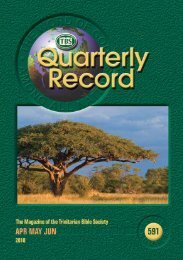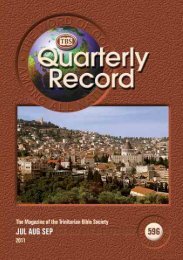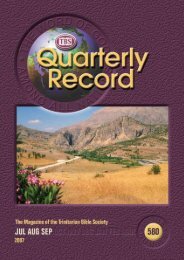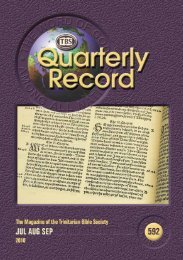Click to Download Document [pdf] - Trinitarian Bible Society
Click to Download Document [pdf] - Trinitarian Bible Society
Click to Download Document [pdf] - Trinitarian Bible Society
- No tags were found...
Create successful ePaper yourself
Turn your PDF publications into a flip-book with our unique Google optimized e-Paper software.
legacy <strong>to</strong>gether with the conditions ofmodern society, are fac<strong>to</strong>rs that havebeen responsible for the proliferation ofindigenous churches. This movementbegan during the colonial period and didnot end with independence. Of seventhousand-plus indigenous churches inAfrica there are over one hundred andeighty in Kenya, mostly located in westernKenya. These indigenous churches grewin areas where missions had been wellreceived, and response <strong>to</strong> mission teachingwas positive.However, the volatile admixture ofChristian teaching, mission education andrapidly growing cultural nationalism couldnot run in the mission channels. MissionderivedChristian churches came <strong>to</strong> beregarded as imperialistic and aggressivelyhostile <strong>to</strong> African culture, and includedissues now found in the secular media suchas the matter of female circumcision, whichearly on was an extremely fierce area ofconflict between mission Christianity andAfrican culture.Mission churches and the white racewere indiscriminately and collectivelydenounced by some leaders. There weresome who were opposed <strong>to</strong> ‘missionary’Christianity but wished <strong>to</strong> retain aChristian identity: they <strong>to</strong>ok recourse inthe founding of independent churchesand schools. It was not only the rejectionof Western (‘Christian’) education, culture,even medicine, that generated such adisconnection. Some indigenous churchesarose from plain dissatisfaction with theleadership style and paternalism of themission churches. There were also, and stillare, declarations of resentment <strong>to</strong>wardsthe decadence that (they feel) traditionalChristianity <strong>to</strong>lerates. No surprise then thatthey strive <strong>to</strong> make a culturally relevant‘indigenised’ Christianity by incorporatingAfrican traditional religious world-views. 13After independence, many such groupsIssue Number: 599 – April <strong>to</strong> June 201225registered as bona fide churches. They lookfor a buoyant church that reflects Africanspirituality, attaching great importance<strong>to</strong> community life and human relationsand giving women a prominent placein the hierarchy of the church. Thesechurches have experienced growthbecause, they claim, they are so relevant<strong>to</strong> their adherents. We believe rather thata Christian church needs first of all <strong>to</strong> behonestly relevant <strong>to</strong> the Word of God, the<strong>Bible</strong>. I quote from the transla<strong>to</strong>rs’ preface<strong>to</strong> the Authorised Version: ‘But now whatpiety without truth? what truth (whatsaving truth) without the word of God?what word of God (whereof we may besure) without the Scripture?’ 14 With this, wenow turn <strong>to</strong> consider TBS and the <strong>Bible</strong> inKenya.<strong>Bible</strong> MattersSwahiliSwahili or KiSwahili is a Bantu language,and five million people speak it as theirnative language; the <strong>to</strong>tal number ofspeakers is said <strong>to</strong> exceed one hundredmillion. Originally written in Arabic script,Swahili orthography is now based on theLatin alphabet introduced by missionariesand colonial administra<strong>to</strong>rs. In the AfricanUnion 15 there is <strong>to</strong>day growing pressure forthe overall use of Swahili as the unifyinglanguage of Africa south of the Sahara.What great need, then, for a sound <strong>Bible</strong>version in this language!By 1844, a foundation had been laid forthe translation of the <strong>Bible</strong> in<strong>to</strong> KimvitaKiSwahili (the Mombasa dialect) by Krapf.Very soon standardisation of the languagebecame an issue, and in the 1920sKiunguja KiSwahili (the Zanzibar dialect)was favoured. The need for a commonKiSwahili <strong>Bible</strong>, blending as far as possiblethe most used dialects, led in 1950 <strong>to</strong> aNew Testament—the KiSwahili Union


![Click to Download Document [pdf] - Trinitarian Bible Society](https://img.yumpu.com/44904205/27/500x640/click-to-download-document-pdf-trinitarian-bible-society.jpg)


![The Love of the Truth [pdf] - Trinitarian Bible Society](https://img.yumpu.com/49788277/1/184x260/the-love-of-the-truth-pdf-trinitarian-bible-society.jpg?quality=85)
![Bible Word List and Reading Plan [pdf] - Trinitarian Bible Society](https://img.yumpu.com/46882563/1/177x260/bible-word-list-and-reading-plan-pdf-trinitarian-bible-society.jpg?quality=85)
![Download Document [pdf] - Trinitarian Bible Society](https://img.yumpu.com/44584740/1/184x260/download-document-pdf-trinitarian-bible-society.jpg?quality=85)



![Download Document [pdf] - Trinitarian Bible Society](https://img.yumpu.com/41007786/1/184x260/download-document-pdf-trinitarian-bible-society.jpg?quality=85)
![Click to Download Document [pdf] - Trinitarian Bible Society](https://img.yumpu.com/40894484/1/188x260/click-to-download-document-pdf-trinitarian-bible-society.jpg?quality=85)


![Download Document [pdf] - Trinitarian Bible Society](https://img.yumpu.com/39425868/1/184x260/download-document-pdf-trinitarian-bible-society.jpg?quality=85)
![Download Document [pdf] - Trinitarian Bible Society](https://img.yumpu.com/39425821/1/184x260/download-document-pdf-trinitarian-bible-society.jpg?quality=85)